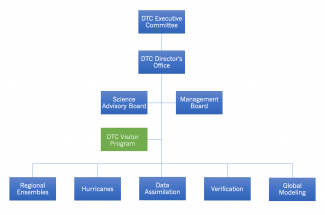The Developmental Testbed Center (DTC) was established in 2003 with a mission to facilitate research to operation transitions in regional Numerical Weather Prediction (NWP). The DTC fulfills this mission by (i) providing community support for regional operational systems, (ii) performing testing and evaluation of NWP innovations for possible operational implementation, and (iii) promoting interaction and collaboration between research and operational NWP communities through special workshops, visitor programs, and the publication of this newsletter.
When the DTC was first established, the initial focus was the Weather Research and Forecasting (WRF) model. In fact, during the early days the DTC was called the “WRF” DTC. Over the years, the scope and activities of the DTC have expanded in response to the needs of operational centers and the research community. Today, the DTC provides support for five community systems, including WRF, UPP (Unified Post-Processor), HWRF (Hurricane WRF), GFDL vortex tracker (a component of HWRF), GSI-EnKF data assimilation system, and the MET (Model Evaluation Tools) verification system. This work has been valuable in encouraging the research community to use operational NWP systems for research applications, and has contributed to their continued improvement.
Currently, efforts are grouped into five task areas focused on the operational systems the DTC supports: Regional Ensembles, Hurricanes, Data Assimilation, Verification and Global Modeling. The Global Modeling task was added in 2015, in response to the request from the NWS NGGPS (Next Generation Global Prediction System) Program Office, to establish a Global Model Test Bed (GMTB). The development and community support of a Common Community Physics Package are the initial foci of GMTB.
A key objective of the NGGPS program is upgrading the current operational Global Forecast System (GFS) to run as a unified, fully-coupled model within the NEMS (NOAA Environmental Modeling System) infrastructure. This unified model is expected to improve hurricane track and intensity forecast, and extend weather forecasting out to 30 days, in addition to other objectives. The NGGPS program presents an exciting opportunity for the U.S. NWP community to collaborate on the development of a single modeling system, which can then be used to support both the research and operational sectors.
In the last issue of the DTC Transitions Newsletter, Environmental Modeling Center (EMC) Director Mike Farrar articulated how the migration of the legacy GFS spectral model dynamic core to the FV3 (Finite Volume Cubed Sphere Version 3) core represents a first step toward unified modeling. The consolidation of EMC’s modeling suite will concentrate resources and result in considerable savings.
The DTC Executive Committee has asked the DTC to develop a strategic vision for the next 10 years to ensure it evolves hand-in-hand with the operational center, and aligns its activities in support of the unified modeling transition. This is a very welcome request -- it has been challenging to support multiple modeling systems with limited resources.
This summer, DTC staff will begin to develop this new vision. The overarching question is: “What is the role of the DTC in the NGGPS era with unified modeling?” How should a complicated unified and fully-coupled Earth system model with multiple components be supported to the community, and what is the DTC’s role in the support of such a system? With limited resources, where should the DTC focus its testing and evaluation efforts to most effectively facilitate R2O transition? How effective are the DTC community engagement activities and should they be revised to further support collaboration and interaction between research and operational NWP communities?
Our goal is to develop a draft strategic vision by the end of the summer. The DTC Strategic Vision will be vetted with the DTC Science Advisory Board and the DTC Management Board, before it is submitted to the DTC Executive Committee for consideration.

